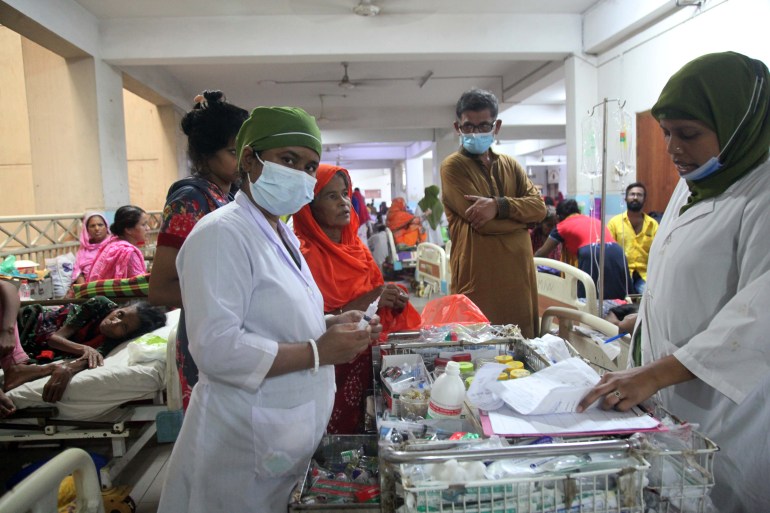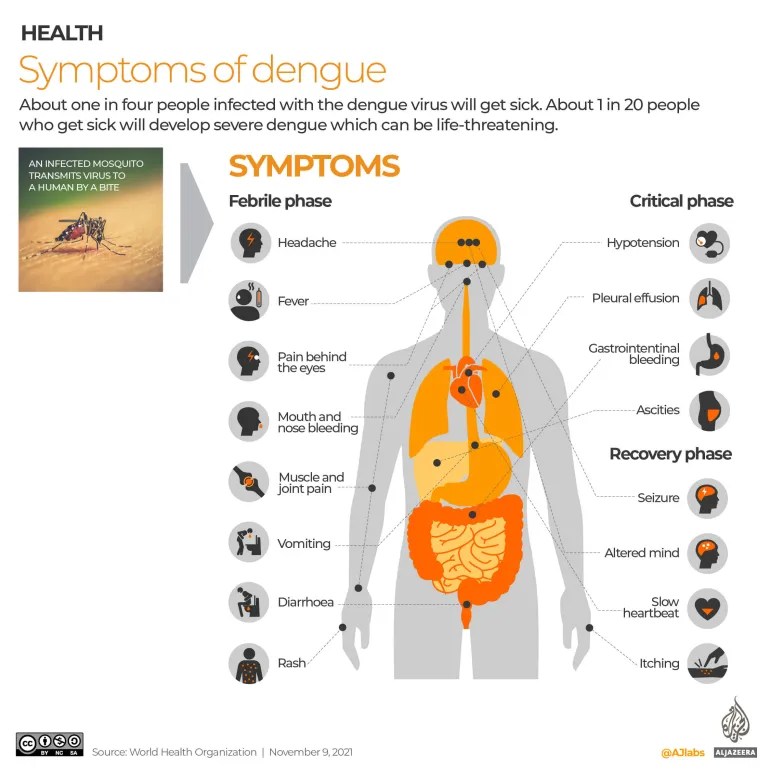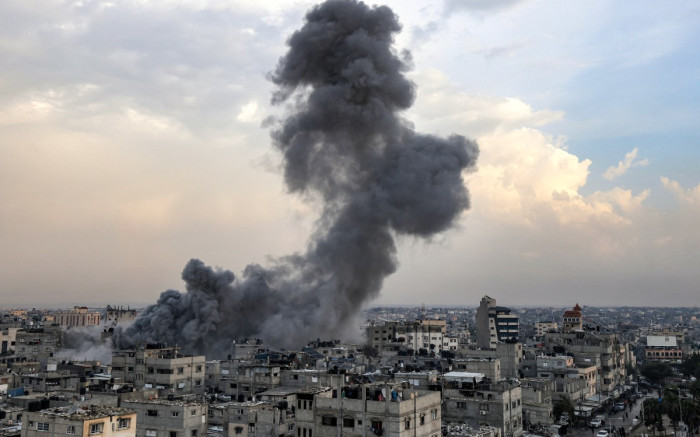
Dhaka, Bangladesh – Every time Mosammat Mayna enters the dengue ward at Mugda Hospital in Bangladesh’s capital, she is overcome with sadness and fear.
The 23-year-old has been working as a cleaner at the hospital for almost a month and the only reason she got the job was because her sister Maria Ratna died of dengue last month while doing her duty as a cleaner in the same ward .
“My sister worked tirelessly for months during this year’s dengue outbreak and ended up contracting the disease. After her death, the hospital management offered me her job,” Mayna told Al Jazeera.
“Our family was devastated by Ratna’s death, but since I was jobless, I accepted the offer even though I was very scared.”
Bangladesh is experiencing its worst dengue outbreak ever, hospitals are overcrowded and the death toll is rising. Last Wednesday, the country recorded 24 deaths – the highest number in a day – due to the mosquito-borne disease.
While the disease does not spread from person to person, a mosquito that bites an infected patient becomes a vector and can transmit dengue fever to others it bites. This makes places with a high concentration of dengue patients – like the hospital where Mayna works – more dangerous for those who are not yet infected.
Health experts are alarmed because dengue fever usually goes away South Asian region when the annual monsoon rains end at the end of September.
As of Monday, at least 1,549 people in Bangladesh – including 156 children from newborns to 15 years old – have died from the disease. According to the government’s Directorate General of Health Services, a total of 301,255 dengue cases were recorded this year (DGHS).
The Record deaths are about five times last year’s death toll of 281 – the highest in a single year in Bangladesh’s history – until this year’s outbreak. The highest number of cases in a year so far – 1,01,354 – was reported in 2019.
“I have never experienced a dengue outbreak of this magnitude,” said Dr. Mohammed Niatuzzaman, director of Mugda Hospital, told Al Jazeera, adding that patients were pouring in from across the densely populated country. “It is very unusual to see so many dengue patients in November.”
Outbreak of “epidemic” proportions
Previous dengue outbreaks have been largely confined to densely populated urban centers such as the capital Dhaka, home to more than 23 million people. Experts say the disease has reached every district this year, including rural areas.
According to the DGHS data, 65 percent of cases reported this year came from outside Dhaka – the first time the capital had fewer cases than the rest of the country.
Sohaila Begum came to Mugda Hospital from southern Patuakhali district with her 11-year-old daughter, who had high fever for more than a week. With no beds available, they remain in the hospital hallways.
“When her fever got worse, doctors at the district hospital told us to immediately take her to a good hospital in the cities,” she told Al Jazeera, adding that her daughter’s situation had improved.
“We came to Dhaka but now we are running out of money. Everything is so expensive here. We will be in trouble if we stay any longer.”

Public health expert and former DGHS director Dr. ANM Nuruzzaman told Al Jazeera that this year’s outbreak was the case nothing less than an epidemic.
“The problem is that the seriousness of dengue has, so to speak, disappeared from the public and media radar as the country experiences political turmoil ahead of the next elections,” he said.
Bangladesh is expected to hold general elections on January 7 as political uncertainty and violence grip the country as the main opposition Bangladesh Nationalist Party (BNP) calls for the ouster of the ruling Awami League government and the establishment of an interim government calls to ensure free elections and fair polls.
“Dengue fever is a serious crisis as the pattern and severity of the disease has changed and worsened. The government should have declared it a public emergency long ago,” Nuruzzaman said.
Government officials maintain that they have done everything they can to contain the spread of dengue and that declaring it a public emergency or an epidemic would not have made much difference.
“All government hospitals across the country have been directed to open dedicated dengue wards in early August. The Ministry of Health has also allocated an emergency budget to combat the outbreak,” said Dr. Mohammad Robed Amin, Director of Noncommunicable Diseases at DGHS, told Al Jazeera.
“The problem is that our country’s health system has serious limitations because we are a large population and it is almost impossible to ensure health care and treatment for everyone,” he said.

Amin noted that the number of cases and deaths this year is “unusually high” for several reasons. “The first and most important reason is the overwhelming prevalence of the Den-2 type dengue fever strain among patients,” he said.
Dengue fever comes in four types: Den-1, Den-2, Den-3 and Den-4. After infection, a person becomes immune to one type of dengue, but not to other types.
“In recent years, there have been mostly Den-3 strains in Bangladesh and people had developed immunity to it. But this year, over 75 percent of patients were diagnosed with Den-2 and almost all patients who died were affected by this particular strain,” Amin said, adding that several studies have found that the Den-2 outbreak is worse if it is followed after years of Den-3 prevalence.

Another reason for the high deaths is the outbreak in rural areas, he said.
“This year the disease has spread across the country and health facilities are very scarce in rural areas. Additionally, most people are unaware of the severity of the disease. If not treated in time, it can be fatal. And that has happened in many areas.”
What caused the record deaths?
Meanwhile, entomologists say they may have found the possible reason for this year’s record outbreak.
Kabirul Bashar, a professor of medical entomology at Jahangirnagar University in Bangladesh, told Al Jazeera that the pattern of dengue decline changed in September last year when the disease peaked in October, causing 86 deaths. A year earlier, in 2021, that number was 22.
“We sounded the alarm last year and said that the clinical picture had changed. Now dengue is no longer a monsoon-related disease but a year-long disease,” said Bashar, who is also the sole scientific expert in the country’s National Anti-Dengue Committee.
The scientist said climate change is changing patterns in temperature, precipitation and other natural phenomena.
“Now we are seeing almost monsoon-like, consistent rain in October and early November. “It alters the reproduction and life cycle of Aedes mosquito populations,” he said, referring to the type of mosquito that transmits dengue.

Dengue fever occurs primarily in South and Southeast Asia between June and September, when stagnant water provides the ideal habitat for the Aedes mosquito, which typically breeds in clean water and feeds during the day.
But in a groundbreaking discovery, Bashar, who has been studying mosquitoes for more than two decades, discovered that the mosquitoes are now even breeding in dirty sewers and salty seawater.
“On the one hand, there are unusually consistent rainfalls in the off-season, which provide an ideal breeding ground for their mosquitoes, and on the other hand, the mosquitoes expand their horizons for reproduction. It’s a double whammy,” he told Al Jazeera.
Entomologists also discovered that the two most commonly used insecticides, malathion and temephos, had become “useless” against Aedes mosquitoes in Bangladesh.
“These two insecticides have become sub-insecticides and are losing their effectiveness against mosquitoes because they have developed resistance,” said Md Golam Sharower, professor at the National Institute of Preventive and Social Medicine.
“Unfortunately, most of our municipal businesses across the country are still using these two insecticides, which do very little to help control the mosquito population.”
Bashar said the government must adopt a comprehensive five-year plan to curb the spread of dengue and eventually eradicate the Aedes mosquito population.
“The disease will only get worse in the coming years if such a plan is not implemented immediately,” he said.
Back at Mugda Hospital in Dhaka, Mayna, overwhelmed by the unusually long dengue epidemic, begins to regret her decision to work as a cleaner.
“I thought the dengue fever would subside with the end of the rainy season, but patients continue to come every day. Forget the ward beds, there is no space even in the hospital corridors,” she told Al Jazeera.
“I’m afraid I might end up like my sister.”






Recent Comments